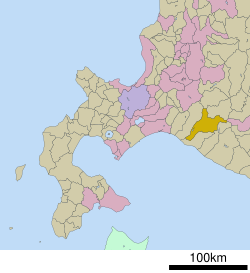Biratori, Hokkaido
Town in Hokkaido, Japan From Wikipedia, the free encyclopedia
Biratori (平取町, Biratori-chō) (Ainu: ピラ・ウトゥル, romanized: pira-utur[1]) is a town located in Hidaka Subprefecture, Hokkaido, Japan. The name of the town means 'between the rocky cliffs' in the Ainu language.[2]
You can help expand this article with text translated from the corresponding article in Japanese. (February 2024) Click [show] for important translation instructions.
|
Biratori
平取町 | |
|---|---|
Town | |
 Biratori Town hall | |
 Location of Biratori in Hokkaido (Hidaka Subprefecture) | |
| Coordinates: 42°35′N 142°8′E | |
| Country | Japan |
| Region | Hokkaido |
| Prefecture | Hokkaido (Hidaka Subprefecture) |
| District | Saru |
| Government | |
| • Mayor | Yoshiteru Nakamichi |
| Area | |
• Total | 743.16 km2 (286.94 sq mi) |
| Population (October 1, 2020) | |
• Total | 4,776 |
| • Density | 6.4/km2 (17/sq mi) |
| Time zone | UTC+09:00 (JST) |
| City hall address | 28, Honchō, Biratori-chō, Saru-gun, Hokkaidō 055-0192 |
| Website | www |
| Symbols | |
| Bird | Great spotted woodpecker |
| Flower | Lily of the Valley |
| Mascot | Bilicky (ビラッキー) |
| Tree | Katsura (Cercidiphyllum japonicum) |
As of October 2020, the town has an estimated population of 4,776 and a density of 6.4 persons per km2. The total area is 743.16 km2.
Ainu culture
The Nibutani Dam was constructed in Nibutani (二風谷) district on the Saru River, though there was a strong objection due to a sacred meaning of the place for indigenous Ainu people. Nibutani is the site of the Ainu Cultural center. Nibutani's best known son is perhaps Shigeru Kayano, a 20th-century advocate for the Ainu people and Ainu language and culture. The cultural landscape along the Saru, consisting of Ainu traditions and modern settlement within Biratori, has been designated an Important Cultural Landscape.[3]
Demographics
Per Japanese census data,[4] the population of Biratori has declined over the past half-century.
| Year | Pop. | ±% |
|---|---|---|
| 1970 | 10,770 | — |
| 1980 | 8,494 | −21.1% |
| 1990 | 7,352 | −13.4% |
| 2000 | 6,503 | −11.5% |
| 2010 | 5,596 | −13.9% |
| 2020 | 4,776 | −14.7% |
Economy
Biratori is primarily an agricultural town, growing many different kinds of fruits and vegetables for people and livestock. Tomatoes are one of the top products of the town. It was also known for its lumber industry.
Tourist attractions
Some noteworthy attractions in Biratori:
- Biratori Onsen Yukara
- Family Land
- Nibutani and the Nibutani Ainu Culture Museum
- Suzuran Field in Memu, where Lily of the Valley (also known as Maybells) bloom from May to June. The field covers 15 hectares and is the largest in Japan. It opened to the public in 1963, but had to be closed in 1975 due to damage from overpicking and trampling. It was able to open again ten years later..
- The UFO park (Set up as a UFO observation platform, it was later closed in the 1970s-1980s.)
Culture
Mascot

Biratori's mascot is Bilicky (ビラッキー, Birakkī). His name is a pun on "be lucky". He is a tomato with a horn and hooves of a bull, a pig's nose and a lily of a valley on his back. His birthday is 12 September.[5][6]
Notable people
- Shigeru Kayano (1926–2006), leading figure in the Ainu ethnic movement.
- Ryo Fukui (1948–2016), jazz pianist.
See also
References
External links
Wikiwand - on
Seamless Wikipedia browsing. On steroids.



